June in the Grand Canyon
Learn all about what it means to visit Grand Canyon National Park in June
Updated: 10/26/22
June is the warmest, driest month of the year in Grand Canyon National Park. It’s also one of the most popular, as it marks the beginning of the busy summer tourist season. June is a great month for visiting the South Rim or the North Rim, for white water rafting, and for hiking the popular Corridor trails (South Kaibab, Bright Angel, and North Kaibab.)
Benefits of Visiting in JUNE
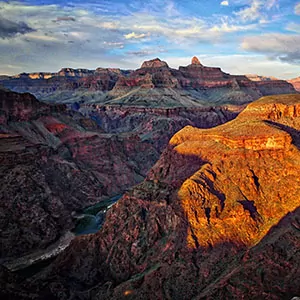 The biggest benefit of visiting the Grand Canyon in June is that the weather on both rims is wonderful and chances of rain are very slim. While the park is famed for its intense heat (rightly so in the canyon), the rims are a mountainous alpine environment where the temperature in the summer never becomes sweltering. Even earlier in the season in March, April, and May when the weather inside the canyon is kinder, the chances of rain (or in some of those months, snow) on the rims is greater. The rain has the possibility not only to prevent activities but also to cloud (literally) your view of the canyon. In June however, you are not likely to have any precipitation and your time on the rims will be lovely. June is also a great time for rafting the Colorado River, as the temperatures in the canyon are 100+ degrees, making the frigid water feel quite refreshing. The lack of rainfall in June makes this month better for rafting than July or August as the latter months are monsoon season which can cause flash flooding to block side hikes and create more treacherous rapids than you bargained for.
The biggest benefit of visiting the Grand Canyon in June is that the weather on both rims is wonderful and chances of rain are very slim. While the park is famed for its intense heat (rightly so in the canyon), the rims are a mountainous alpine environment where the temperature in the summer never becomes sweltering. Even earlier in the season in March, April, and May when the weather inside the canyon is kinder, the chances of rain (or in some of those months, snow) on the rims is greater. The rain has the possibility not only to prevent activities but also to cloud (literally) your view of the canyon. In June however, you are not likely to have any precipitation and your time on the rims will be lovely. June is also a great time for rafting the Colorado River, as the temperatures in the canyon are 100+ degrees, making the frigid water feel quite refreshing. The lack of rainfall in June makes this month better for rafting than July or August as the latter months are monsoon season which can cause flash flooding to block side hikes and create more treacherous rapids than you bargained for.
Another advantage is that the North Rim is open, and at 8,000 feet, its summer temperatures are perfect. The North Rim is closed to wheeled traffic from mid-May to mid-October, so visiting the park in June allows visitors to check out a unique and distinct part of the park. The park receives almost 6 million visitors a year, and the North Rim receives less than 15% of visitors and is quieter and remote.
Almost a thousand feet higher in elevation than the South Rim, it will be less hot here if the South Rim is having a heat wave and you’ll be able to escape many of the crowds for a more remote and wild experience. The North Rim also has more wildlife in general (because of the lack of groups) and is the only place in the park where you can see bison. Wildlife is another benefit of visiting in June as the animals are very active on the rims for the pleasant weather and the reptiles and amphibians are out in the canyon for visitors to enjoy. June is a great time to visit the park for many reasons; there is a reason it marks the beginning of the busy summer season.
Drawbacks of Visiting in JUNE
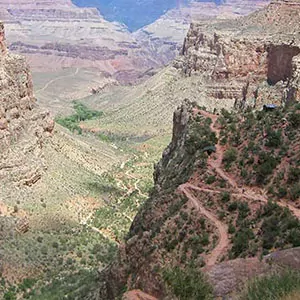 One of the biggest drawbacks of visiting in June is it’s the beginning of the park’s busy summer season and is crowded. This means lines for shuttles, crowded parking lots, and sometimes long lines of traffic. The visitor centers and other museums will be very crowded during midday as the heat grows more intense and visitors flock to the air-conditioned buildings. The increase in crowds also means that accommodation rates will go up and availability will go down. Planning a last-minute trip to Grand Canyon in the summer is at best a headache and at worst impossible without staying hours outside the park. If you do find any accommodations that are available, you will have to shell out peak season prices that are much higher than in the off-seasons. Some people think that because of the heat, summer is the less busy season and thus plan to go in summer to avoid the crowds that surely are avoiding the heat. Unfortunately, this is not the case. The heat does not scare the masses away and the rims are quite pleasant (although a little warm) in summer when the crowds flock to the park.
One of the biggest drawbacks of visiting in June is it’s the beginning of the park’s busy summer season and is crowded. This means lines for shuttles, crowded parking lots, and sometimes long lines of traffic. The visitor centers and other museums will be very crowded during midday as the heat grows more intense and visitors flock to the air-conditioned buildings. The increase in crowds also means that accommodation rates will go up and availability will go down. Planning a last-minute trip to Grand Canyon in the summer is at best a headache and at worst impossible without staying hours outside the park. If you do find any accommodations that are available, you will have to shell out peak season prices that are much higher than in the off-seasons. Some people think that because of the heat, summer is the less busy season and thus plan to go in summer to avoid the crowds that surely are avoiding the heat. Unfortunately, this is not the case. The heat does not scare the masses away and the rims are quite pleasant (although a little warm) in summer when the crowds flock to the park.
The other major drawback is the intense heat. As mentioned before, the rims are fairly pleasant in the summer, the canyon itself grows intensely hot the further you descend. This makes any hiking and backpacking potentially dangerous. Temperatures on the canyon floor can reach well into the triple digits and feel even hotter if you are in the sun and/or exerting yourself. Iconic hikes such as a rim-to-rim hike or simply reaching the canyon floor come with additional risks of heat exhaustion or heat stroke. Not only does the heat make shorter treks more dangerous and often uncomfortable, but it also makes longer treks potentially out of the question because certain distances are too far to trek without water refill stations.
Such heat makes taking a few hour’s rest in the shade during midday heat advisable as long-term sun exposure can cause serious injury and speed the onset of heat exhaustion or heat stroke. If you want to hike or backpack the Grand Canyon in June, we strongly recommend going with a guiding company. The expert guide on the trip will make sure to proper safety precautions are being taken and that everyone on the trip knows how to stay safe on the trail. While it will still be incredibly hot, going with a guide who knows the area and is accustomed to hiking in this environment will greatly reduce your chance of injury or illness.
Things to Do in JUNE
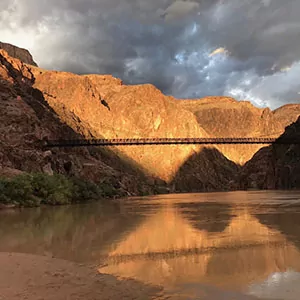 The activities to do in June at Grand Canyon are nearly endless. One of the best things to do is to choose to spend time at the North Rim, which is 1,000 feet higher than the South Rim and sees only 15% of the visitation. The higher elevation of the North Rim allows for cooler temperatures than its southern cousin and due to its remote location, it is less frequented and wilder. The wildlife here is abundant and the trails have less traffic and noise pollution.
The activities to do in June at Grand Canyon are nearly endless. One of the best things to do is to choose to spend time at the North Rim, which is 1,000 feet higher than the South Rim and sees only 15% of the visitation. The higher elevation of the North Rim allows for cooler temperatures than its southern cousin and due to its remote location, it is less frequented and wilder. The wildlife here is abundant and the trails have less traffic and noise pollution.
Hiking here is fantastic. Trekking on the North Kaibab Trail, enjoying Grand Canyon Lodge, and hiking the Widforss trail are all worthwhile. The North Rim has many of the same activities as the South Rim but with fewer people and less heat. However, it is far less famous and more difficult to access from the more populated area south of the park.
The South Rim is wonderful in June. At the South Rim, Day hiking into the Canyon is fun as long as you start early (before sunup) and are prepared with plenty of water and food. June is a prime month for hiking Rim to Rim, but it’s best to start early or join a guided tour. If you want to do this hike on your own in a single day, you should start before sunup and take a rest in the afternoon during the heat of the day under the cottonwoods in Bright Angel Creek or near Phantom Ranch. Doing a rim-to-rim hike in a single day is discouraged (but not prohibited) by the National Park Service. There are many other day hikes that descend into the canyon only for a few miles before reaching a waypoint where guests can turn around.
Camping on the rims is great in June and worth doing at Mather Campground or the North Rim Campground. There are camping tours available that provide gear, reservations, meals, transportation, and guided hikes each day.
Rafting in the Grand Canyon is extremely popular in June as the intense summer temperatures make getting splashed with the Colorado River’s frigid waters refreshing. Rafting the Colorado River can be done in as little as 6 days and is an experience you’ll never forget. Sighting seeing is wonderful in June as well as the lack of adverse weather to block your view of the canyon allows you to be able to rely on this activity. Taking the shuttle or biking/walking down Hermit’s Rest Scenic Road is well worth the time as the road has a plethora of overlooks and viewpoints. Photography is also spectacular due to the lack of adverse weather. Night sky photography is very popular among photographers as you can depend on the sky to be clear for the milky way to show up against the colorful canyon walls.
If the weather is unusually hot or if you’re looking for a way to spend the heat of the day indoors, the Yavapai Geology Museum which has fantastic exhibits on the fossils and geology in the park, or the Kolb Studio and photo gallery are great options as well as the visitor center on the South Rim, which has an excellent, 22-min film about the park and the surrounding area. Native American and early settler history is also available to see in the park at the Tusayan Museum and Ruin, Eagle Point Native American village on the west rim, or the Desert View Watchtower to the east. The Grand Canyon Railway is a great option for those wanting to travel back in time and entertain the kids with a live bandit ambush. A stroll on the Grand Canyon Skywall or dinner at the famous El Tovar restaurant all also great options. There are nearly endless things to do in the Grand Canyon in June, so gear up for the adventure of your choice.
Things to see in June
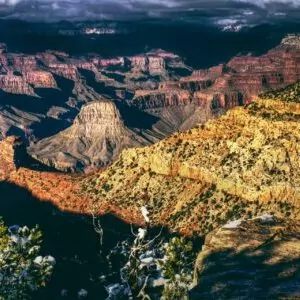 There are almost as many things to see in June as there are to do and with the weather so hot in the canyon, sightseeing on the rim where it is cooler is one of your best options. The park has many unique sights to offer visitors from views of the canyon itself, to wildlife on the rims, to mining and early settler history, to Native American ruins, to geological features. What you want to see really depends on what you are interested in, so make sure to do your own research about what there is to see in the park as this list is by no means exhaustive.
There are almost as many things to see in June as there are to do and with the weather so hot in the canyon, sightseeing on the rim where it is cooler is one of your best options. The park has many unique sights to offer visitors from views of the canyon itself, to wildlife on the rims, to mining and early settler history, to Native American ruins, to geological features. What you want to see really depends on what you are interested in, so make sure to do your own research about what there is to see in the park as this list is by no means exhaustive.
Hopi Point: Known as one of the best overlooks in the park for sunrise or sunset viewing, Hopi Point is a must-see for visiting among clear June skies. Along Hermit’s Rest Scenic Drive, you can either take the shuttle here or walk/bike along the path yourself and stop at each of the vista points.
Fossils: The park boasts a fascinating geological history and has many fossils that visitors can see, including the famous extinct reptile tracks that are preserved in stone. Ask a range about where you are likely to find fossils in the park or where specific marked ones are located.
North Rim: The North Rim is almost like another park and there are many things to do and see. Although it is quite a drive from the South Rim as you have to drive all the way around the canyon, it is well worth it for the unique views, remote landscape, and quieter setting with fewer crowds.
Desert View Watchtower: This watchtower located close to the east entrance to the park seems to rise out of the very canyon walls itself. Make this your first stop when entering the park from the east, explore the recreated Native American Kiva on the first level, and enjoy the stunning canyon views on the upper levels.
Havasupai Garden: This oasis was used by Native Americans to grow food for centuries. Tucked away off Bright Angel Trail, this shaded area with a stream, plenty of shade, and a campground are well worth a stop even just to catch your breath from hiking.
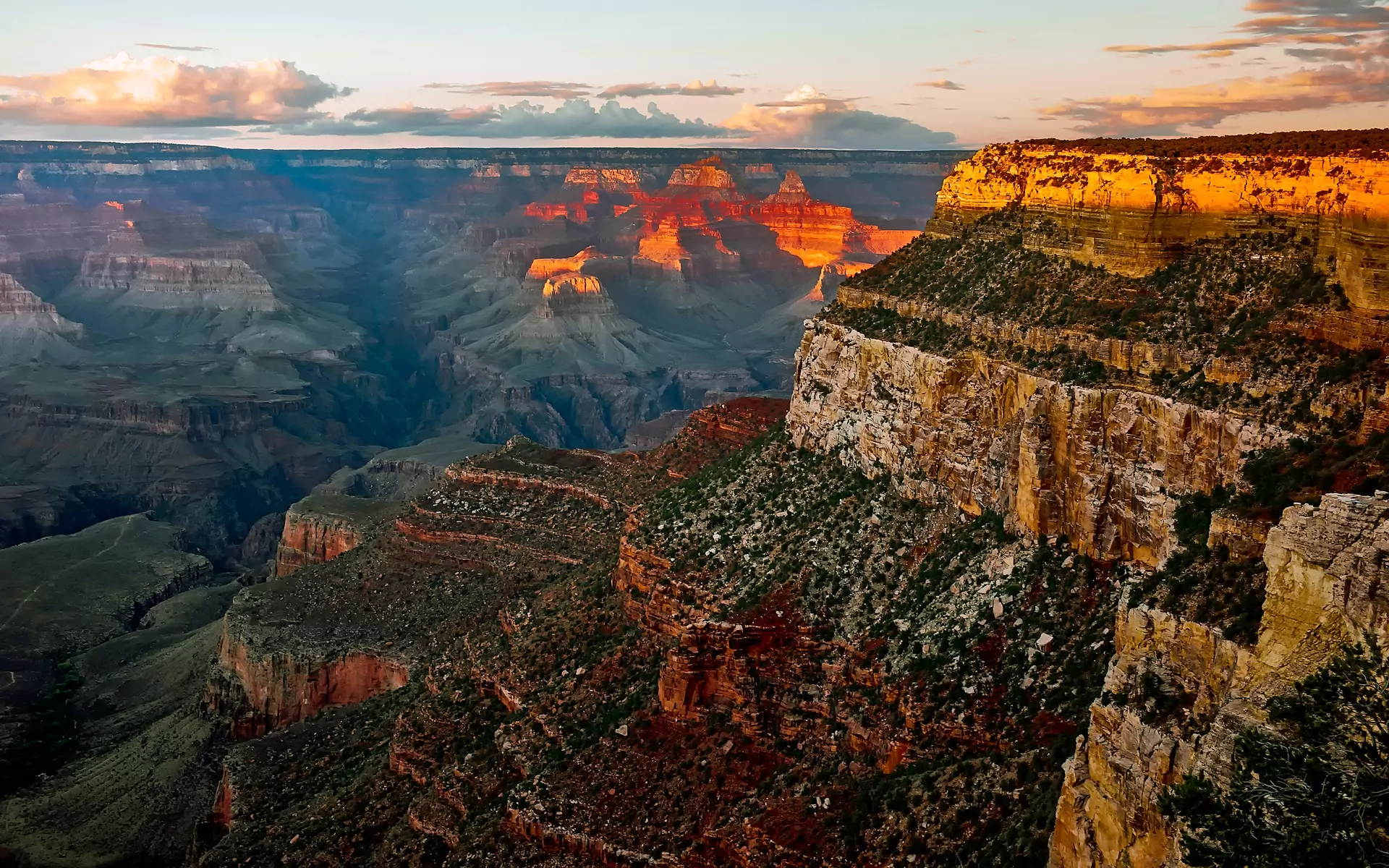
Hiking in JUNE
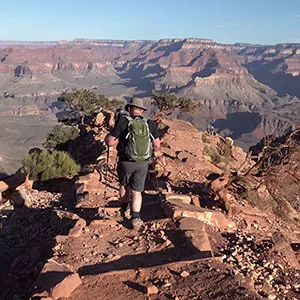 Hiking the Grand Canyon in June is worth doing, but it’s important to not take it lightly, as it is potentially dangerous. For backpacking trips, we strongly recommend staying on the Corridor Trails (South Kaibab, Bright Angel, and North Kaibab), and even South Kaibab is worth avoiding except on day hikes as it has little shade and no water. Hiking in summer is no joke and can lead to serious illness and even death. Rangers at Phantom Ranch treat multiple cases of heat exhaustion a day in the summer and the park has a few cases of heat stroke per year which is often the result of heat exhaustion that is left untreated. To be prepared for summer hiking in the Canyon, plan on starting early and being off the trails before 11 am. Most guests that needed medical treatment from heat illnesses were hiking in the 10 am to 4 pm range in the heat of the day. Many guests are lured into hiking unprepared by the cooler temperatures at the rim and the initial downhill hiking. Do not be fooled; the temperature increases with every step you take further into the canyon and hiking back out can double the time it took you to hike down. Have at minimum 3 liters of water for you on day hikes, and 6 liters on backpacking trips. Make sure to be kind to yourself and chose a trail length that will be fun and comfortable for your skill and fitness level instead of exhausting and dangerous.
Hiking the Grand Canyon in June is worth doing, but it’s important to not take it lightly, as it is potentially dangerous. For backpacking trips, we strongly recommend staying on the Corridor Trails (South Kaibab, Bright Angel, and North Kaibab), and even South Kaibab is worth avoiding except on day hikes as it has little shade and no water. Hiking in summer is no joke and can lead to serious illness and even death. Rangers at Phantom Ranch treat multiple cases of heat exhaustion a day in the summer and the park has a few cases of heat stroke per year which is often the result of heat exhaustion that is left untreated. To be prepared for summer hiking in the Canyon, plan on starting early and being off the trails before 11 am. Most guests that needed medical treatment from heat illnesses were hiking in the 10 am to 4 pm range in the heat of the day. Many guests are lured into hiking unprepared by the cooler temperatures at the rim and the initial downhill hiking. Do not be fooled; the temperature increases with every step you take further into the canyon and hiking back out can double the time it took you to hike down. Have at minimum 3 liters of water for you on day hikes, and 6 liters on backpacking trips. Make sure to be kind to yourself and chose a trail length that will be fun and comfortable for your skill and fitness level instead of exhausting and dangerous.
It is important to know the dangers of hiking in the canyon in summer before you go. The best way to prevent serious conditions due to heat is to hike when it’s not hot. Start your hike before sunrise and finish before 11 am. If you find yourself in a situation where you are beginning to climb out of the canyon in the heat of the day, wait. It is worth waiting a few hours for the heat to subside instead of risking illness to climb out. It is recommended to keep a flashlight in your pack so that you can have the option of hiking in the dark if a situation has kept you longer than you anticipated. It is important to know the difference between heat exhaustion and heat stroke as the latter is a medical emergency and needs immediate treatment.
While heat exhaustion can result in excessive sweating, cool and moist skin, thirst, nausea, and headache, heat stroke victims have dry hot skin, rapid weak pulse, and confusion. This is because a victim of heat stroke’s body has stopped trying to cool itself down. Without an ability to regulate body temperature, this condition can cause coma or even death if left untreated. Dehydration can also contribute to heat born conditions because of excessive sweating and loss of water.
Another life-threatening condition that the park has seen increasing occurrences of in the last few years is water intoxication, scientifically called hyponatremia. This condition comes from an individual being overzealous in drinking water. The excess water intake combined with the loss of sodium through sweating can create an imbalance in sodium levels in the bloodstream, causing cells to swell. If this swelling takes place in the brain, it can lead to death. Make sure to be eating salty snacks as well as replenishing electrolytes while you hike and not to force fluids. For more summer safety tips, check out the National Park Services Hike Smart Tips. For those wanting to hike in the summer, it is highly advisable to go with a guiding company, even on just a day hike to make sure you have a certified, expert guide who is accustomed to hiking in the region and will know how to react in an emergency situation.
backpacking in june
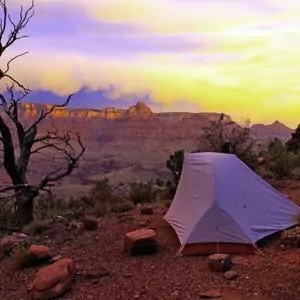 June is the hottest month in the Grand Canyon and is difficult for backpacking and longer treks. This is due to the intense heat in the canyon that makes even day hiking dangerous at times. If you want to do a rim-to-rim hike but can only make it to the park in the summer, you can do this by backpacking and staying at the bottom of the canyon where there is water and shade instead of doing the full hike in one day. Of course, the increased weight on your back will have the potential to make you lose more water to sweating and be more susceptible to heat. You will also want to start your backpacking hikes before sunrise in order to beat the heat and get off the trail before the sun becomes too scorching. Anything beyond a rim-to-rim backpacking trip on the corridor trails should not be attempted on your own in Grand Canyon unless you are an experienced desert hiker.
June is the hottest month in the Grand Canyon and is difficult for backpacking and longer treks. This is due to the intense heat in the canyon that makes even day hiking dangerous at times. If you want to do a rim-to-rim hike but can only make it to the park in the summer, you can do this by backpacking and staying at the bottom of the canyon where there is water and shade instead of doing the full hike in one day. Of course, the increased weight on your back will have the potential to make you lose more water to sweating and be more susceptible to heat. You will also want to start your backpacking hikes before sunrise in order to beat the heat and get off the trail before the sun becomes too scorching. Anything beyond a rim-to-rim backpacking trip on the corridor trails should not be attempted on your own in Grand Canyon unless you are an experienced desert hiker.
If you want to do a longer trip, consider booking a trip with a guiding company that will take care of much of your gear, itinerary, and all the safety logistics. Our expert guides at Wildland Trekking are seasoned in desert hiking and will know what to expect and what to do in an emergency situation. Summer in Grand Canyon is not to be laughed at and comes with some serious dangers, but it can be rewarding if you are willing to put in the work to make sure your trip is safe and enjoyable.
Weather in JUNE
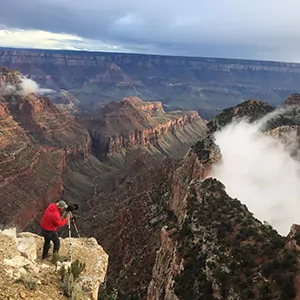 As you have probably gathered if you have read the rest of this page, the weather in the Grand Canyon varies wildly depending on where you are, what elevation you are at, and most importantly whether or not you are in the canyon. June on the rims is much like summer in the mountains: warm and dry during the day but with temperatures that drop sharply at night. The average high at the South Rim in June is 82 degrees Fahrenheit, and the average low is 43 degrees Fahrenheit (high of 28 degrees Celsius, low 6 degrees Celsius). Low 40s is definitely a sweatshirt or down jacket worthy and if you’re camping, you’ll want to bring sleeping bags rated for lower temperatures.
As you have probably gathered if you have read the rest of this page, the weather in the Grand Canyon varies wildly depending on where you are, what elevation you are at, and most importantly whether or not you are in the canyon. June on the rims is much like summer in the mountains: warm and dry during the day but with temperatures that drop sharply at night. The average high at the South Rim in June is 82 degrees Fahrenheit, and the average low is 43 degrees Fahrenheit (high of 28 degrees Celsius, low 6 degrees Celsius). Low 40s is definitely a sweatshirt or down jacket worthy and if you’re camping, you’ll want to bring sleeping bags rated for lower temperatures.
In the canyon, however, temperatures skyrocket as the desert habitat takes over and you plummet in elevation. Temperatures inside the canyon can be warmer than at the rim by 10-20 degrees in the shade and feel even warmer in the sun. The average high at Phantom Ranch on the canyon floor in June is 103 degrees Fahrenheit, and the low of 72 degrees Fahrenheit (39H/22L degrees Celsius.) The average number of days of rain in June is 1. Guests should keep in mind that 103 is the average high on the canyon floor in June, i.e. the middle of what the highs will be. It is not uncommon to see much higher numbers, sometimes reaching into the one hundred teens with 120 being the hottest ever recorded. Lesson to be learned: don’t hike in the heat of the day as you will regret it.
June is the driest month in the park, which many visitors like because fewer clouds make the canyon less often obscured and the wet weather doesn’t get in the way of activities on the rim. Visitors that are staying on the rims should also be prepared for the elevation, as the South Rim is at around 7,000 ft and the North Rim around 8,000. For those used to living at or just above sea level, these heights can cause shortness of breath and quicker exhaustion than you would experience exerting the same effort at home. If you stay for more than a few days, you should acclimate to the altitude so the shortness of breath feeling will go away. If it does not or if you begin to experience severe headache and nausea, check in with a ranger or medical personnel to assess the likelihood of altitude sickness. Although 8,000 ft is not typically high enough for this condition, altitude sickness can be life-threatening and it is important to take precautions.
As we talked about in the hiking section, heat exhaustion, heat stroke, and water poisoning are very real risks if you decide to hike into the canyon. If you are staying on the rims, particularly if you are camping, be aware of the dangers of hypothermia at night and bring layers to keep warm. Make sure to check the forecast each day before setting out on your activities and bring appropriate clothing for all of the regions you will be visiting in the park. With so many different options, you are sure to find a place in this park where the weather suits what you’d like to do, whether it be bundled up around the campfire at night or getting drenched with freezing river water to cool down in the 100+ degree air.
Wildlife in june
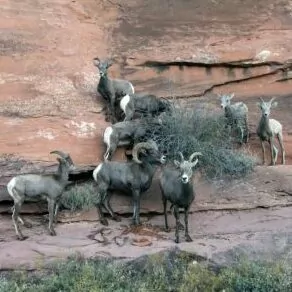 The Grand Canyon is full of biodiversity and hundreds of species of animals call this place home, so it can be great for wildlife viewing any time of year. But in the canyon in June, some of the animals are going to think it’s too hot to be out, much like you do. The frogs and toads will be out almost exclusively at night so that they do not dry out in the intense heat of the day. Snakes and lizards may even get too hot on the scorching rocks, but make sure to still keep an eye out for rattlesnakes and never let little ones hike in front of (or behind) the group by themselves. Birds in the canyon, especially raves, can often be seen with their beaks open. Since birds don’t sweat, this is a cooling mechanism.
The Grand Canyon is full of biodiversity and hundreds of species of animals call this place home, so it can be great for wildlife viewing any time of year. But in the canyon in June, some of the animals are going to think it’s too hot to be out, much like you do. The frogs and toads will be out almost exclusively at night so that they do not dry out in the intense heat of the day. Snakes and lizards may even get too hot on the scorching rocks, but make sure to still keep an eye out for rattlesnakes and never let little ones hike in front of (or behind) the group by themselves. Birds in the canyon, especially raves, can often be seen with their beaks open. Since birds don’t sweat, this is a cooling mechanism.
Some of the larger animals at the rims, however, will be out during the day as the weather is nice and the nights are still cool. Elk, mule deer, big horn sheep, and even bison (exclusively on the North Rim) can be seen in the park foraging on grass and foliage. While Grand Canyon does not have bears, coyotes, bobcats, and mountain lions are a few of the predators that live here, though the two felines are rarely seen. Coyotes are seen quite frequently in campgrounds on the rims, searching for leftover scraps.
It is important to keep all food safely secured and to not feed any animals you see as this can make them aggressive which will require their removal from the park. Even the rocks squirrels that are so common on the rims should not be fed. Squirrels injure more visitors in the park than any other animal, mostly from scratches and bites as they beg and try to steal your food. This is a result of other humans feeding them in the past and is why it is important not to feed or approach any wildlife you see.
One of the most famous wildlife residents in the park which can be seen in June is the California condor, the largest– and one of the rarest– birds in North America. With a wing span that can reach 9.5 ft, these birds are truly massive and can travel many miles a day, rather like a land version of the sea-born wandering albatross. These birds have been brought back from the brink of extinction through captive breeding programs and their numbers are steadily increasing, although are still very low. They are often confused with turkey vultures while in flight but the condor is much larger, has white splotches on the underside of its wings, and flies smooth and stable while the turkey vulture appears to “wobble” when it flies. One of the staples of the park, these birds are truly majestic and can often be seen flying along the rims, riding the updrafts of warm air from the canyon. This park is truly swarming with wildlife and you won’t regret asking a ranger about where the best spot is to see a particular animal or spending some time searching for the one you want to see.
Recommended wildland trips june
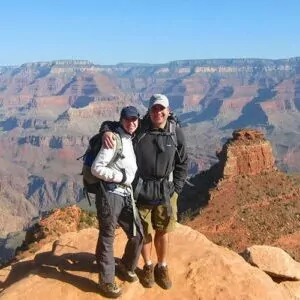 Planning a trip to the Grand Canyon in June is often a headache as you have to prepare all your gear and keep up with the current conditions and safety information about the heat in the canyon and cold (at least at night) on the rims. We recommend booking a trip with a guiding company in June so you can bypass all the headaches and hassle of planning the trip yourself. Especially if you are looking to do day hiking or go on a backpacking trip in June, it’s best to go with one of our expert guides at Wildland who knows the area, is accustomed to desert hiking, and will know how to recognize safety or medical concerns. Even inn-based tours and camping trips will be much more relaxed if you know you have a leader who knows the park’s dangers and best spots. Feel free to explore all the trips we offer in the Grand Canyon, but here are a few we especially recommend for June.
Planning a trip to the Grand Canyon in June is often a headache as you have to prepare all your gear and keep up with the current conditions and safety information about the heat in the canyon and cold (at least at night) on the rims. We recommend booking a trip with a guiding company in June so you can bypass all the headaches and hassle of planning the trip yourself. Especially if you are looking to do day hiking or go on a backpacking trip in June, it’s best to go with one of our expert guides at Wildland who knows the area, is accustomed to desert hiking, and will know how to recognize safety or medical concerns. Even inn-based tours and camping trips will be much more relaxed if you know you have a leader who knows the park’s dangers and best spots. Feel free to explore all the trips we offer in the Grand Canyon, but here are a few we especially recommend for June.
South Rim Basecamp Tour: For those looking to experience the best of the Grand Canyon while having the luxuries of access to showers and comfortable camping facilities, this is the trip for you. Experience phenomenal natural and cultural history, distinct hikes that take you more than halfway into the canyon, and wonderful, fresh camping meals. Don’t miss out on this all-inclusive 3-day tour.
Summer Rim to Rim in the Grand Canyon: This hike is on the bucket list for many hikers, but attempting it in June on your own can be dangerous unless you’re an experienced desert hiker. This guided hike will let you experience this rim-to-rim trek while being guided by an expert who has done the trek before. Take advantage of this amazing trip and explore this remarkable canyon from rim to rim.
Grand Circuit Inn Based: Get a taste of the North and the South Rims on this inn-based tour that will take you to multiple distinct sections of the canyon. Go on 5+ day hikes, eat at the historic El Tovar, stay near the rims, and enjoy the incredible views on this all-inclusive, 5-day tour with the comfort of showers and lodges and the experience of the Grand Canyon.
Phantom Ranch Tour: This iconic lodge at the bottom of the Grand Canyon is a great alternative to backpacking as the rooms are primitive but comfortable and you get to stay inside. Enjoy this 2 to 3-day trip with a possible layover day at the bottom of the canyon where you can relax and enjoy the creek. This is an inn-based trip, but you’ll need to carry (or let a mule carry) some of your belongings to the canyon floor and back up again on the hike back.
Join a Guided Hiking Adventure
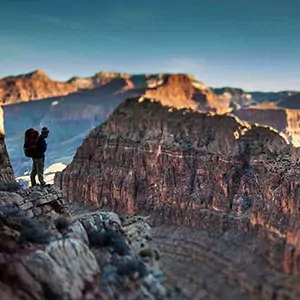 Grand Canyon National Park is home to some of the most unique and spectacular hiking vacations in the world. Wildland Trekking offers trips with stunning views, geologic history, and incredible hiking and backpacking for visitors who want to have an active, adventurous experience.
Grand Canyon National Park is home to some of the most unique and spectacular hiking vacations in the world. Wildland Trekking offers trips with stunning views, geologic history, and incredible hiking and backpacking for visitors who want to have an active, adventurous experience.
Guided Grand Canyon treks include permits, local transportation (excluded on certain tours), meals, gear, risk management systems, and professional guides, allowing guests to make the most of their visit to the Canyon, focus 100% on enjoying their experience, and do it all with an increased level of safety and comfort.
GRAND CANYON ADVENTURE TOURS
- GUIDED BACKPACKING ADVENTURES: these are for people interested in an authentic adventure deep in the Canyon’s wilderness.
- HORSE-ASSISTED TRIP: on this trip to the bottom of the Canyon, guests hike with light day packs and camp near the Colorado River.
- PHANTOM RANCH TOURS: this tour (limited dates) goes to the bottom of the Canyon where we sleep 1 or 2 nights in the Phantom Ranch Lodge 5 minutes from the Colorado River. Showers, A/C, heat…etc.
- ALL-INCLUSIVE HIKING PACKAGES: inn-based and camping-based hiking packages provide all-around hiking experiences of the Grand Canyon.
- DAY HIKE TOURS: maximize your day at Grand Canyon on a fully guided, award-winning hiking tour on one of the Park’s best trails.





